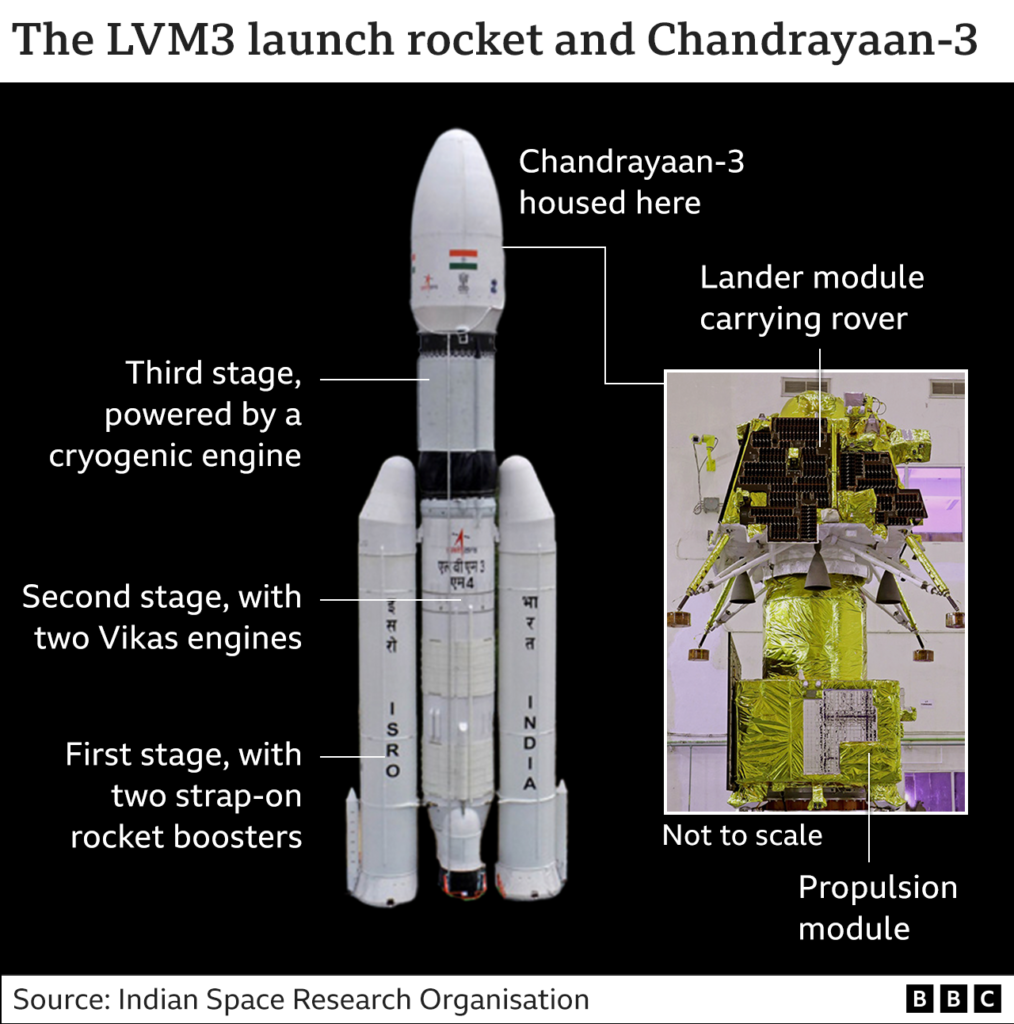Highlights
· The Chandrayaan-3 Moon lander and rover mission was launched by the ISRO, Indian Space and
Research Agency.
· On July 14, the spacecraft was successfully launched. Around August 23 or 24, it is anticipated to
land near the southern polar area of the Moon.
· The Chandrayaan-3 lander and rover are outfitted with scientific tools that will improve our
comprehension of the Moon.
What is Chandrayaan-3?
The third Moon mission by India’s ISRO space agency is called Chandrayaan-3. The objective is to deploy a lander and rover on the lunar surface and keep them there for around 14 Earth days, or one lunar day. The lander will carry the diminutive rover, which has a weight of only 26 kilogrammes (57 pounds), to the Moon. Both vehicles have scientific equipment for studying the surface.
The Chandrayaan-3 mission’s lander and rover are conceptually identical to those from Chandrayaan-2. The Chandrayaan-2 Vikram lander successfully descended to a distance of 5 kilometres (3 miles) from the Moon in September 2019 and switched to “fine braking” mode, which would have gently lowered it to the lunar surface. Chandrayaan-2, like its predecessor, was aiming for the south polar region of the Moon, where ice has been discovered inside craters that are always in shadow.
Vikram unfortunately drifted off course due to a technical error, and ISRO officials lost communication with the spacecraft. Later, NASA’s Lunar Reconnaissance Orbiter discovered the vehicle’s wreckage dispersed 750 metres (a half mile) away from the designated landing site.
Despite the mission’s failure, Chandrayaan-2 contained an orbiter that is still monitoring the Moon from above. The orbiter can look for water ice among other things for science.
Knowing what ultimately destroyed the Vikram lander, ISRO claims they have improved the lander’s software and carried out a number of tests to make sure Chandrayaan-3 proceeds as planned. Although Chandrayaan-3 does not have an orbiter, its propulsion module, which will launch the lander into lunar orbit, is outfitted with a science equipment that will study Earth as though it were an exoplanet and collect data for upcoming exoplanet research.
How will Chandrayaan-3 get to the lunar surface?
Chandrayaan-3 will land on the moon after around 40 days since its launch.
The mission started on July 14 with a launch aboard India’s heavy lift LVM3 rocket, which can carry around 8 metric tonnes into low-Earth orbit. (By way of contrast, the SpaceX Falcon 9 rocket is capable of launching over 23 metric tonnes into low-Earth orbit.)
The extended Earth orbit created by the LVM3 will have an apogee, or high point, of roughly 36,500 kilometres (22,700 miles) above the globe. This orbit will also include a propulsion module that is linked to the ship. Before entering lunar orbit, the propulsion module will boost its orbit many times.
Chandrayaan-3 will be lowered to the Moon by the propulsion module until it is in a circular orbit that is 100 kilometres (62 miles) in diameter. The lander will then deorbit and touch down in the south polar area of the Moon when the two vehicles separate at that location. The lander should be travelling at less than 2 metres per second in the vertical and 0.5 metres per second in the horizontal at the time of impact (6.5 and 1.6 feet per second, respectively).
What will Chandrayaan-3 do on the Moon?
A successful touchdown would be a major accomplishment for ISRO and would add them to a select group of countries that have successfully landed spacecraft on other planets. Beyond this accomplishment, Chandrayaan-3 has technological and scientific tasks to complete.
The Chandrayaan-3 lander’s side panel will quickly unfold after landing to act as a ramp for the rover. After driving down the ramp and emerging from the lander’s belly, the rover will start investigating the lunar surface.
The solar-powered lander and rover will have two weeks to explore their surroundings. They are not made to withstand the brisk lunar night. Only the lander, which is in direct contact with Earth, may be reached by the rover. According to ISRO, the Chandrayaan-2 orbiter can serve as a backup communications relay.
The rover has two payloads:
• The LIBS (Laser Induced Breakdown Spectroscope) analyses the surface to determine its chemical and mineralogical makeup.
• Alpha Particle X-ray Spectrometer (APXS): Identifies the surface’s elemental makeup. Magnesium, aluminium, silicon, potassium, calcium, titanium, and iron are among the specific elements the rover will search for, according to ISRO.
The lander has four payloads:
• Radio Anatomy of Moon Bound Hypersensitive ionosphere and Atmosphere (RAMBHA): Tracks the temporal evolution of the local plasma and gas environment.
• Chandra’s Surface Thermophysical Experiment (ChaSTE) investigates the thermal characteristics of the surface.
• The Instrument for Lunar Seismic Activity (ILSA) monitors seismic activity at the landing location to identify the crust and mantle beneath the surface.
• Laser Retroreflector Array (LRA): A lunar ranging study retroreflector donated by NASA. Laser ranging involves firing a laser at a reflector and timing how long it takes for the signal to return. Using retroreflectors that were left over from the Apollo programme, NASA continues to estimate the distance to the Moon.

